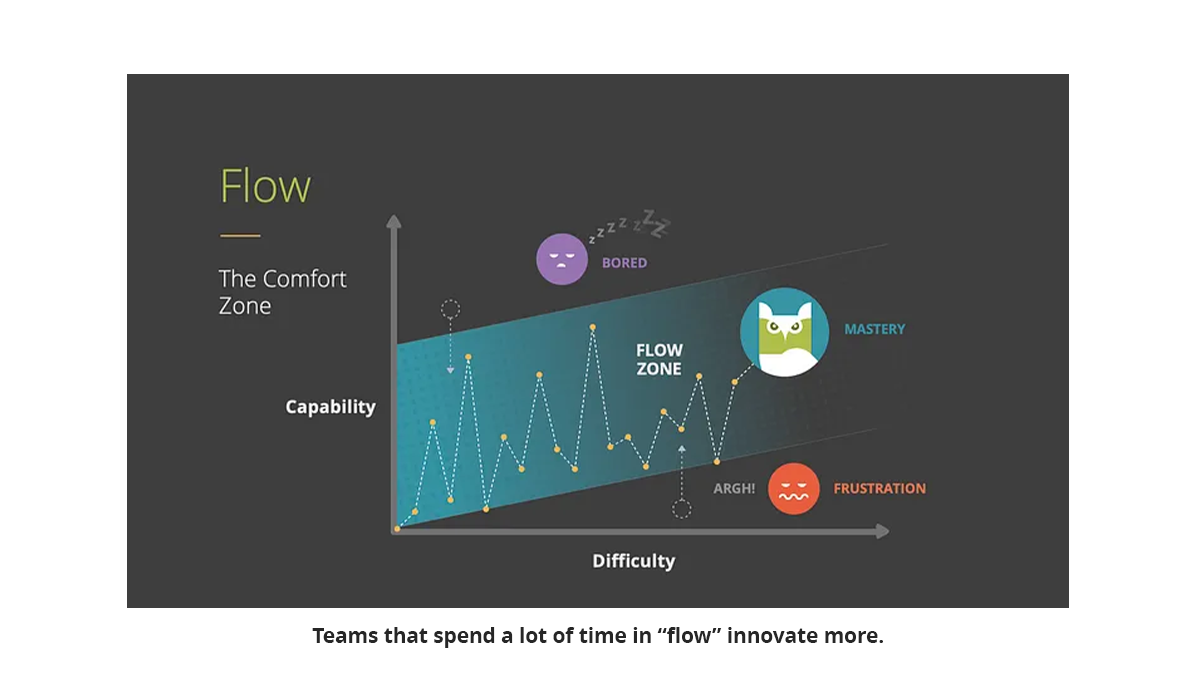Teams that grow together, flow together
When a team is in “flow,” they are happier, more satisfied with their work, and innovations abound. The innovations that result are not always where you would expect them. Sometimes, they are small and they result in improvements in efficiency or even the overall happiness of the team. Those small innovations matter, as they add up.
Teams that are not in flow are often apathetic. They may follow the process, collaborate in prescribed ways, and execute with precision, but not much creativity results. They create predictable results. Maybe that sounds like a good thing, but, over time, these teams always seem to burn out. Teams that consistently produce superior long-term results are those that push on their boundaries in creative ways and innovate regularly.
There is a distinct relationship between innovation and the amount of time that teams spend in flow.
How might we, as leaders, maximize team flow? There are many ways, but I do believe there are some quick win ways purposeful spark more flow. Here is a listicle for you with some links for further reading:
- Increase the team’s focus by communicating and measuring meaningful goals like trust, loyalty, & advocacy. Having goals that inspire your team and demonstrate that their work is improving the lives of those impacted by their work will make everything better.
- Improve the team’s ability to independently prioritize, in the wild, by clearly articulating your vision and the dominance hierarchies in your ecosystem. When teams are aligned on who they are serving and on what problems they are solving, they become more agile, they learn faster, and they will naturally feel more empowered to make more decisions.
- Monitor for motivation, by observing for “alignment, confidence, and commitment.” When you see apathy, resistance or burnout, ask questions and act quickly. Motivation is critical for flow. Understanding how high-quality, intrinsic motivation works is a critical skill for leaders.
- Build a culture that distinguishes “flow” and makes it a priority. The words you use to lead, matter. Set an example by talking about it, celebrating it, working into the stories that are told about your work. Make it a value.
- Make sure your people are growing by understanding and gaining a shared commitment to growth. Teams that grow together are much more effective and motivated. Teams, and most people, fall into apathy with their work when they are no longer growing. If you want motivated and creative teams, make learning and growth a priority.
- Build systems that optimize flow time and minimize wasted human cycles and interruptions. Minimize recurring meetings and waste wherever possible. Prioritize creative time. Carve out time for workshops and group flow. Make space for divergent thinking.
It is hard work to produce things that didn’t exist before. Leadership is about tapping into the creativity of the people around you to create a better future.
Sean Flaherty is Executive Vice President of Innovation at ITX, where he leads a passionate group of product specialists and technologists to solve complex client challenges. Developer of The Momentum Framework, Sean is also a prolific writer and award-winning speaker discussing the subjects of empathy, innovation, and leadership.





